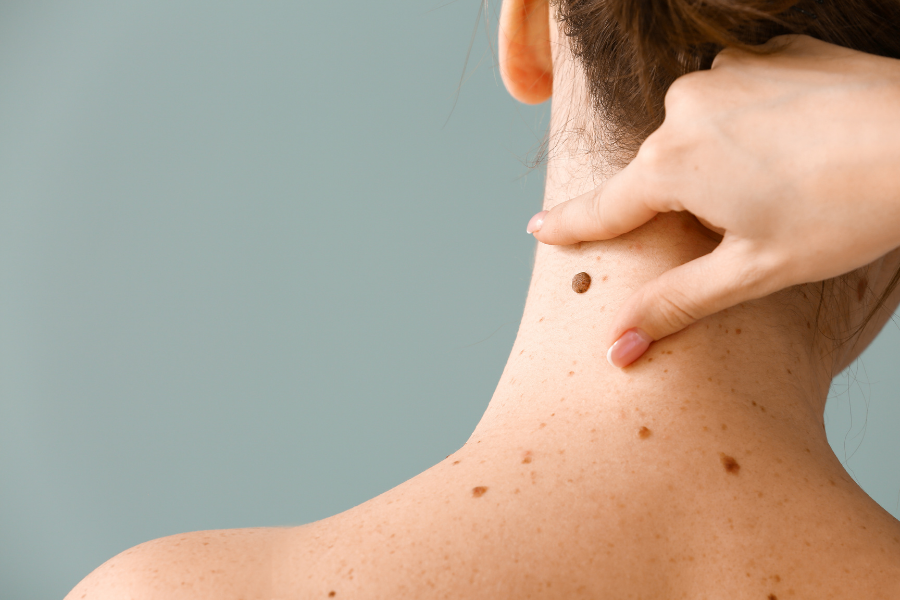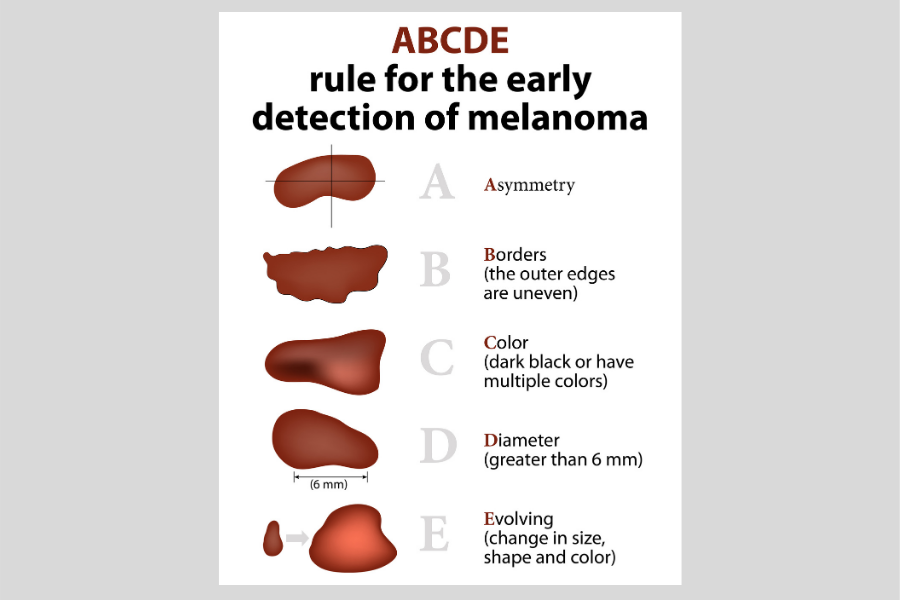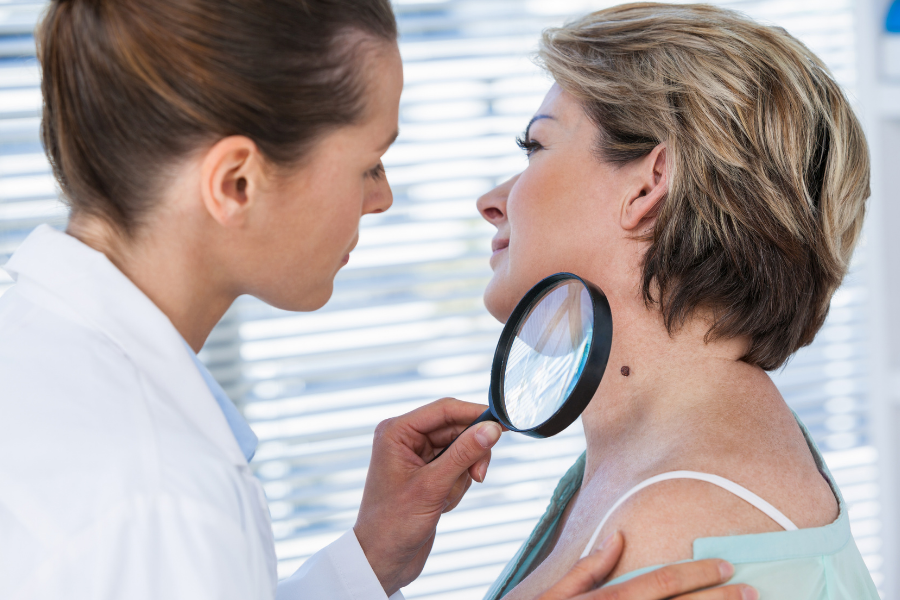There is a common misconception out there about exposure to the sun’s ultra-violet rays and skin cancer.
A lot of people think the risk of skin damage, and even skin cancer is highest during those hot summer months when we’re at the beach or in a park, or on a golf course, for example. So during the cold months of winter, with shorter days, we don’t need to wear sunscreen.
Not so. The risk of skin cancer is a year-round reality.
“You are protecting your skin from the UV rays, not from the summer heat,” says Loiza Azim, Advanced Cosmetic Nurse at HealthOne’s MediSpa & Skin Clinic. “Those UV rays still penetrate through. It doesn’t matter what time of the year it is.”
That said, we are heading into the summer when our awareness of skin damage really ramps up. Also, May is Skin Cancer Awareness Month, so it’s a good time to raise the topic.
Moles appear on our skin, but when do we know if they are cancerous? And at what point do we need to get in and see a doctor?
What Causes Moles On Your Body?
Moles are something you are born with. Moles are caused when cells in your skin, called melanocytes, grow in clusters. They are usually brown or black. Melanocytes are throughout your skin and produce melanin, the natural pigment that gives your skin its colour, Loiza says.
Most moles appear when people are younger, and it’s normal to have 10-40 on your body by adulthood. Some might change over time. Some might stay the same. They may darken with exposure to the sun, for example. The vast majority of moles are benign.
“A normal mole would have an even colour throughout,” Loiza says. “It will also be very even in circumference, the outline of it will look even, and the shape will be either round or oval. A normal mole would be the size of a pea, or smaller than that.”
If you are fair-skinned, you are more susceptible to moles than someone who has a darker complexion.
When Should I Be Concerned About A Mole?
If you have over 40 moles on your body, Loiza says it’s important to do regular self-examinations, especially during those summer months.
If the mole is increasing in size, or if you notice changes in the colour of the mole, or its shape or height, it’s time for a doctor’s check.
What Does A Cancerous Mole Look Like?
There are three major types of skin cancers: basal cell carcinoma, squamous cell carcinoma, and melanoma. The first two are unlikely to spread to other parts of the body if treated early.
A non-melanoma cancerous mole (such as basal cell carcinoma or squamous cell carcinoma) might look like a scaly growth, that bleeds or has a crust, and will normally appear on parts of the body that get the most sun exposure - the nose, ears, forehead, hands.
Are Raised Moles Bad?
“Some are raised, but as long as they are not increasing in size, edges are not irregular or changing colours, then generally it’s okay,” Loiza says. “However if you have a raised mole it’s always a good idea to keep an eye on it or go to the family physician or dermatologist and do a biopsy on it. You can also remove it so it doesn’t become a problem aesthetically.”
What Is Melanoma?
A smaller number of skin cancers are malignant melanomas, which are aggressive and deadly, and can spread fast to other parts of the body if not caught and treated early.
According to government statistics, melanoma accounts for about 3.8 per cent of new cancer cases and 1.9 per cent of all cancer deaths in men, 3.3 per cent and 1.2 per cent respectively in women.
What Does Melanoma Look Like?
“Melanoma has irregular edges,” Loiza says. “It’s wavy around the circumference of the mole. Or there are irregular colours within the mole or multiple different shades of dark brown or black. And it will be larger in surface size as well. These are the three clinical manifestations you need to watch out for.”
Tips for Prevention
Perhaps the most important tip is to wear sunscreen. You should always make sure to cover areas that get the most sun exposure and tan the most easily. “And go to a skin clinic to get proper UV 30 sunscreen, minimum, and re-apply it every four hours,” Loiza says.
Research suggests that UV radiation is one of the most controllable factors when it comes to skin cancer prevention. Here are some additional tips:
- Re-apply the sunscreen if you are swimming or sweating a lot
- Wear a broad-brimmed hat, a long-sleeved shirt and long pants if you have to spend long periods in the sun
- Try to select more shaded areas for outdoor activities
- Avoid using tanning beds or tanning lamps
- Certain medications can make your skin more sensitive to UV rays. Consult with a doctor to learn more about what’s best for your skin.

Seek medical attention if you notice a mole is changing in shape, colour or growing in size. Go see your family doctor or a dermatologist.
At the HealthOne MediSpa & Skin Clinic, practitioners like Loiza can provide a thorough examination of moles that are, or could potentially be concerning.
It’s a good idea she says to go see them for an examination every six months, especially if you are fair-skinned, have a family history of melanoma, suffer sunburns easily, have a history of excessive sun exposure, or have frequented tanning beds.
“With skin cancer, cells are producing at a very high rate,” she says. “Skin cancer often gets missed. And a lot of times you can’t even see your back. And often your back is more exposed to ultra-violet rays than your front, especially if you are wearing a hat. A MediSpa practitioner can also educate you on what to look for.”
If a dermatologist believes a mole needs to be evaluated further, they will do a biopsy by shaving or cutting out a piece of the mole for examination. If it’s cancerous, the dermatologist will cut out the entire mole from the biopsy site, including a small rim of normal skin around the cancerous area.
The bottom line is skin cancer is treatable when detected and treated early on. If it spreads to other parts of the body it can be deadly. That’s why those regular body examinations are so important.

